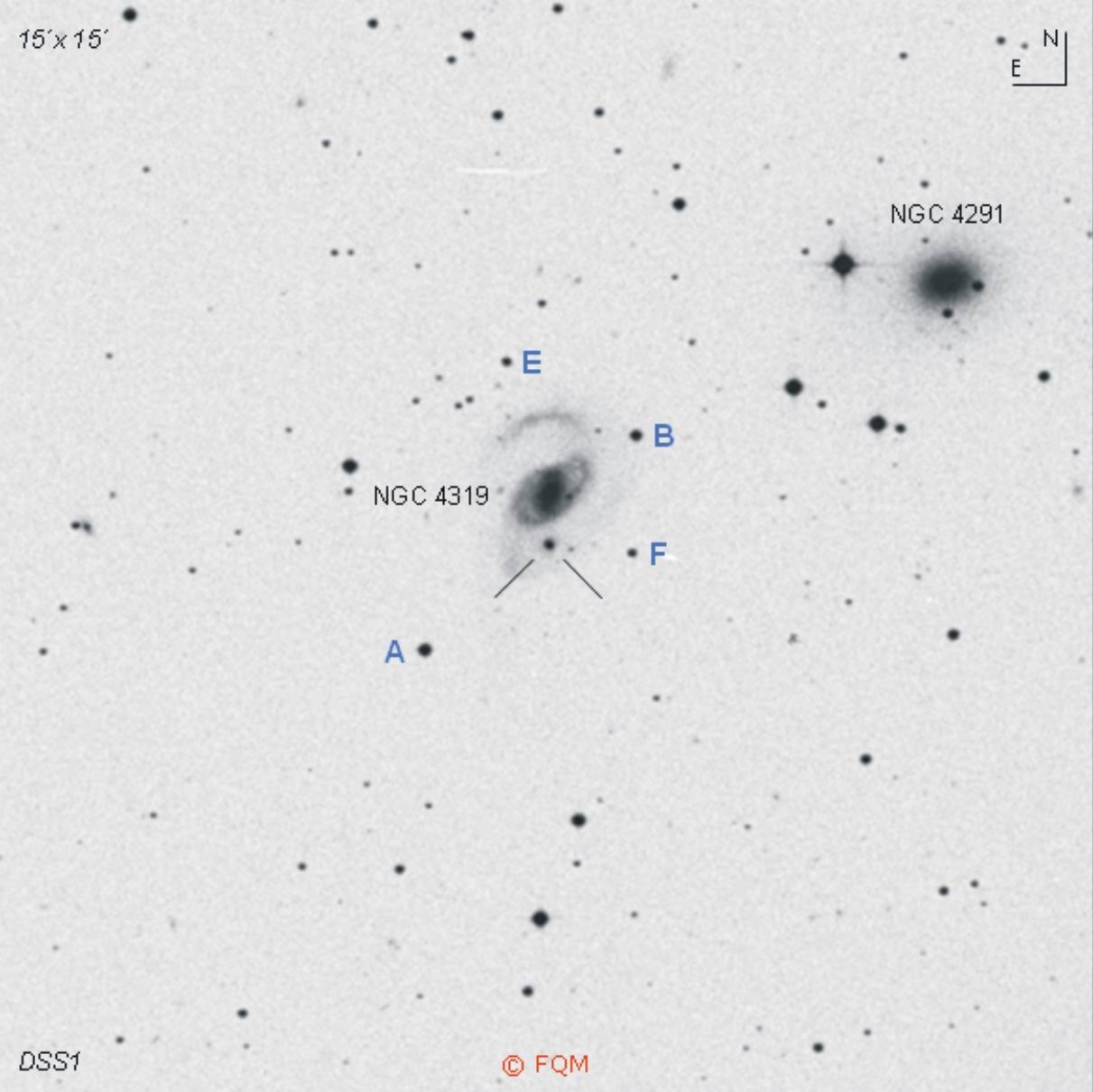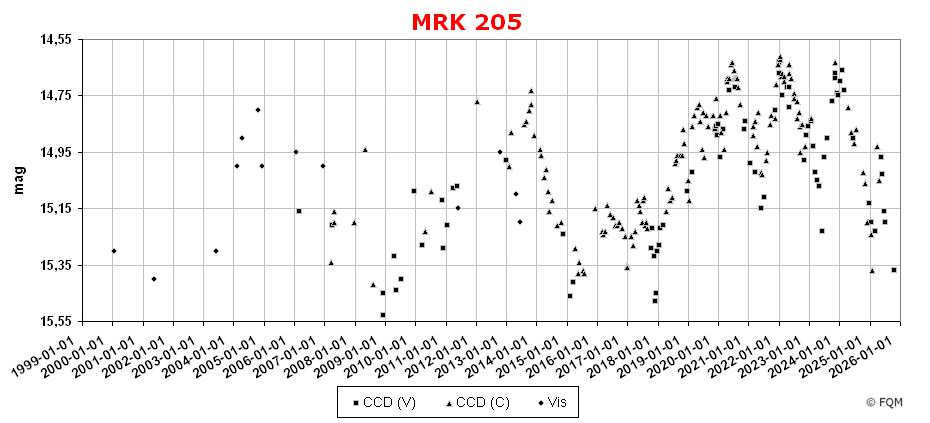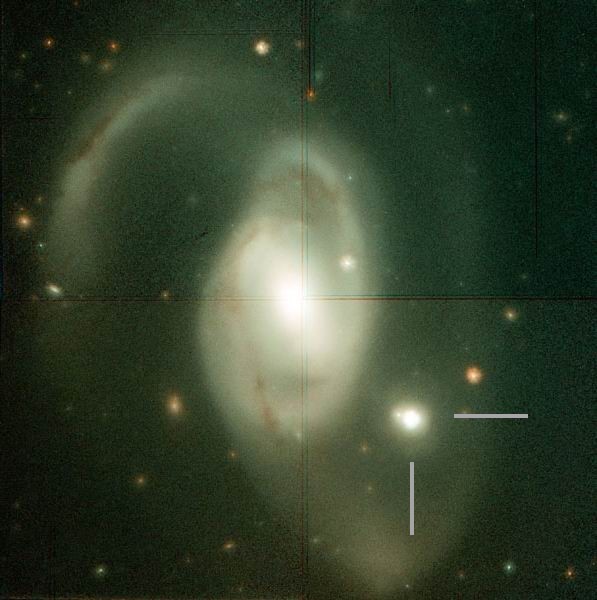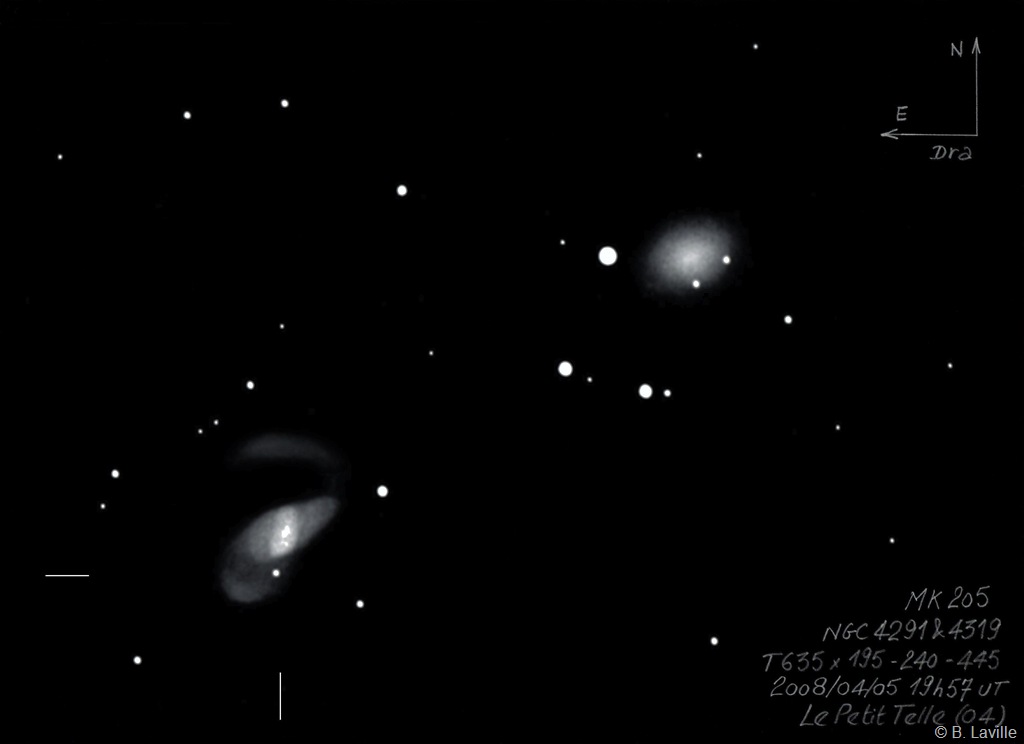
| Frankfurt Quasar Monitoring |
| MRK 205 |
| Cross-Identifications | 1ES 1219+755, MS 1219.6+7535, QSO B1219+7535 1H 1211+762, RX J1221.7+7518, XSS J12206+7509 SWIFT J1222.0+7518, PGC 39975, Markarian 205 IRAS F12195+7535, 1E 1219.6+7535, 1219+755 1RXS J122144.4+751848, 1AXG J122135+7518 |
| Equat. coordinates | RA 12 21 44.1 DE +75 18 38 (J2000) |
| Constellation | Draco |
| Type | AGN |
| Redshift | z=0.070 |
| Distance (2) (3) |
287 Mpc |
| Total mag range (mv) (4) | 14.5 - 15.5 |
| Catalog Magnitude (1) | 15.24 |
| Absolute Magnitude (1) | -22.5 MB |
| Light Travel-Time (2) | 0.905 × 109 yrs |

Comparison stars
| star | B | V | Rc |
| A | 13.601 (0.004) |
12.964 (0.001) |
12.506 (0.093) |
| B | 14.573 (0.006) |
13.925 (0.007) |
13.521 (0.005) |
| E | 15.799 (0.005) |
15.177 (0.005) |
14.805 (0.004) |
| F | 16.375 (0.005) |
15.459 (0.002) |
14.957 (0.003) |



| Markarian 205
(MRK
205 for short)
is an AGN in the most eastern part of Draco, close to the constellation Camelopardalis. MRK
205 (z=0.07) is located in the far cosmological background of spiral
galaxy NGC 4319 (z=0.006). As a star-like object, MRK 205 is shining
through the
southern spiral arm of NGC 4319. The host galaxy of MRK 205 was classified as a
spiral galaxy of type SBab. Initially,
MRK 205 was recognized as a quasar
prototype.
Today, it is classified as an AGN. With an absolute magnitude of -22.5 MB
it does not meet the
quasar classification limit.
MRK
205 was discovered by the UV-Continuum-Survey run by B.E. Markarian et
al. (MRK), searching for blue galaxies with excessive UV-emission. It
was
identified as a quasi-stellar object with Seyfert 1-spectrum by
spectral analysis. An accurate redshift was determined in 1970. Besides
the optical, MRK 205 has also been known as a strong X-ray emitter
(1ES, RXJ, 1H, MS, XSS). In the days, when the true nature of quasars was still puzzling, MRK 205 became a well known object by the publications of Holton Arp. His idea was that quasars are luminous objects, escaping from ordinary galaxies at high speeds, explaining the high redshifts when moving away from the observer. A mysterious lightbridge between MRK 205 and NGC 4319 was argued to prove the galaxy-quasar connection. But his ideas were later disproved. In fact, MRK 205 is about 900 million light-years away from earth, a lot more than NGC 4319, which is some 10 times closer. This close alignment of a bright foreground spiral and a bright background AGN, observable through amateur telescopes, is unique in the heavens. MRK 205 is a low amplitude variable object ranging between mag 14.5 and mag 15.5. Visual observers need at least a 10-inch telescope to glimpse this faint stellar object, close to the bright diffuse nucleus of NGC 4319. The spiral arms of NGC 4319 are only visible through very large aperture telescopes under pristine skies (see sketch above). Together with the neighbouring galaxies NGC 4291 (6´NW) and NGC 4386 (16´NE), MRK 205 is a well rewarding target for both visual observers and CCD observers. Observers shall use the comparison stars given above. ____________
Another
bright extragalactic variable - at a distance of about 600 million
light-years - is MRK 180, which can be found about
6° SE of
MRK 205. |
| Arp, H. 1971, ApL, 9, 1; A Connection Between the Spiral Galaxy NGC 4319 and the Quasi-Stellar Object Markarian 205. Bowen, D.V., Osmer, S.J., Blades, J.C., et al. 1994, AJ, 107, 461; Hubble Space Telescope faint object spectrograph QSO absorption snapshot survey (ABSNA). Gonzŕlez-Pérez, J.N., Kidger, M.R., et al. 2001, AJ, 122, 2055; Optical and Near-Infrared Calibration of AGN field stars: An All-Sky Network of faint stars calibrated on the Landolt System. Hansen, T. 1991, Deep Sky Magazine 34, 32; The "Deepest" Deep Sky Objects. Harrington, P. 1994, Astronomy 6/94, 56; Tracking down a Quasar. Karge, S.; Helle Quasare für 8- bis 10-Zoll Teleskope. Ein Beobachtungsführer zur visuellen Beobachtung von Quasaren und BL Lacertae Objekten; Frankfurt 2005. Markarian, B.E. 1969, Astrofizika, 5, 581; Galaxies with Ultraviolet Continuum III. Osterbrock, D.E., Martel, A. 1993, ApJ, 414, 552; Spectroscopic study of the CfA sample of Seyfert galaxies. Steinicke, W.; Katalog heller Quasare und BL Lacertae Objekte; Umkirch 1998. Steinicke, W.; Beobachtungsliste für helle Quasare; Umkirch 1999. Takalo, L.O., Kidger, M.R., et al. 1992, A&A, 261, 415; First simultaneous UBVRI photopolarimetric observations of a sample of normal quasars. Ulrich, M.-H. 1971, ApJ, 163, 441; Spectrographic Observations of Twenty-Eight Markarian Galaxies. Véron-Cetty, M.-P., Véron, P. 2001, A&A 374, 92; A Catalogue of Quasars and Active Nuclei: 10th edition. Véron-Cetty, M.-P., Véron, P. 2003, A&A 412, 399; A Catalogue of Quasars and Active Nuclei: 11th edition. Véron-Cetty, M.-P., Véron, P. 2006, A&A 455, 776; A Catalogue of Quasars and Active Nuclei: 12th edition. Véron-Cetty, M.-P., Véron, P. 2010, A&A 518, 10; A Catalogue of Quasars and Active Nuclei: 13th edition. Weedman, D.W. 1970, ApJ, 161, L113; A High-Redshift "Seyfert Nucleus" in the Arms of a Spiral Galaxy. Weedman, D.W. 1973, ApJ, 183, 29; A Photometric Study of Markarian Galaxies. Wenzel, K. 1998, Interstellarum 14, 32; Der kosmische Begleiter von NGC 4319. |
| Links: Hamburg Quasar Monitoring Image from Hubble Space Telescope Drawing by B. Laville AAVSO |
| home |